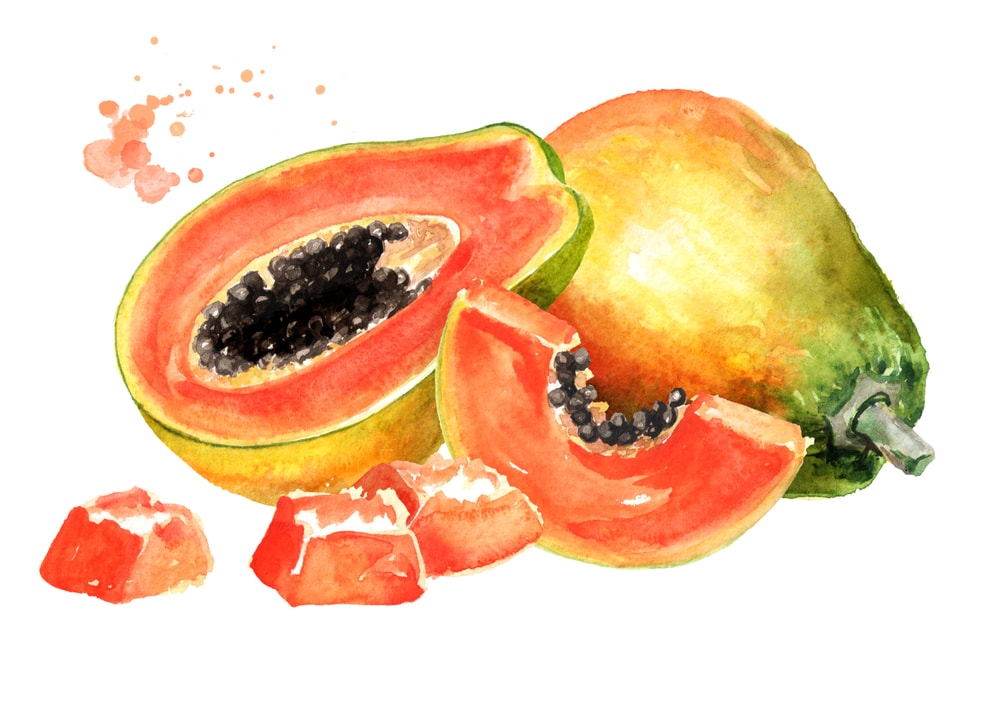
Papayas are a tropical fruit that you’ve probably seen in the grocery store but never purchased.
They’re large, like a melon, and contain sweet, orange-colored flesh.
They’re often used in Asian and Caribbean cuisines, so you may have tried it even if you didn’t know it!
I can count on one hand the times I’ve eaten papaya, but having learned about all the benefits this tropical fruit offers, I think I’ll be seeking it out more and more.
Some of the most healthy, nutrient-filled fruits come to us from tropical locales!
Papayas contain a ton of Vitamin C, as well as other antioxidants and nutrients like Magnesium, Folate, Vitamin A, and Potassium.
They also offer a special digestive enzyme called papain that can help with uncomfortable digestion, sensitive tummies, and even irritable bowel syndrome.
But how do pick the best papaya? How do you know when it’s ripe so you can use it in tasty papaya recipes?
And what does it taste like, anyway? You’ll find all the answers below!
How Do You Know if a Papaya is Ripe?
Not all of us are lucky enough to live where papayas grow on trees, but if you do, take advantage!
Papayas are the most delicious straight from the source.
However, you can enjoy them fresh from the grocery store shelf as well.
There are four easy things to look for that will help you choose an absolutely perfect papaya.
- Color: A ripe papaya should be fading from a bright green to a nice golden yellow. Some papayas also have a bit of orangey red color on their skin too. It should be about 80% yellow for peak ripeness. Some green spots are okay, it will continue to ripen at home – I’ll talk about this more later.
- Give: Similar to a ripe avocado, a ripe papaya should have a little bit of give to it when you push your thumb into it. Place gentle pressure on the larger end to check the papaya’s softness. Again, like an avocado, too soft means too ripe. This is especially true on the stem end of the papaya; avoid the fruit if it is too soft there.
- Bruising: Check for bruises and bad spots. As it gets softer when it ripens, a just right papaya may have a few small spots, but generally the skin should be soft and smooth.
- Smell: If you’re still unsure about papaya selection, try smelling the papaya near the stem. It should smell faintly sweet. No smell means it’s not ripe yet, while an unpleasant, strong smell will mean it is overripe and probably starting to ferment.
How Do You Ripen a Papaya?
If papayas aren’t currently in season, or you only ever see green ones at your local store, don’t worry. You can still buy green papayas, they will continue to ripen if left at room temperature. Here are a few tips and tricks to help you ripen your papaya:
- Lay them on a flat surface to avoid bruising. Rotate them occasionally.
- Keep them out of direct sunlight so they don’t get too hot and ripen too fast.
- Store them in a paper bag in a dark place. All fruits release ethylene as they age. Trapping this natural gas in with the fruit helps the fruit ripen faster.
- Adding a banana, apple, or avocado to the bag may help speed up the ripening process. This is also due to the ethylene released by the other fruits. The more the merrier if you’ve got a super green papaya.
- If your papaya is completely green, it may not fully ripen (but is still edible). You can try to ripen it by scoring it three times from tip to tip. Use a sharp knife and make sure it fully pierces the skin and slices a little into the fruit below.
Alternatively, if you buy ripe papayas and want them to last a little longer, store them in the fridge. If ripe, they’re best within a day or two, but they will last in the refrigerator for up to a week.
If you have too much papaya to eat before it goes bad, you can freeze slices of it and enjoy it in smoothies later.
What Does Ripe Papaya Taste Like?
Papayas are not as sweet as other tropical fruits like mangoes or pineapples. A ripe papaya will be creamy, almost butter-y in texture. It will melt in your mouth with a mild but sweet flavor, similar to a cantaloupe.
If it has little or no flavor, it probably needs to ripen more. Green papayas are still edible, but the texture will be crunchy instead of smooth.
The seeds are also edible and offer an abundance of health benefits as well. But the seeds are anything but sweet. They are bitter and sharp and are often compared to mustard or wasabi.

How to Eat Papaya
You can eat and enjoy a juicy, ripe papaya fresh, or use it in smoothies, salsas, or salads. You’ll want to cut the papaya in half lengthwise and scoop out the sides. You also need to peel the skin off. You can then use a melon baller or cut your papaya into cubes, wedges, or slices.
If eating it raw, I recommend sprinkling a little lime juice on your papaya to bring out its tasty flavors. It’s also great eaten with other tropical fruits like mangoes, passion fruit, kiwis, and berries.
Here are a few other ways to enjoy papaya:
- Like melons, papaya is great wrapped in prosciutto to go with a cheese board or as a solo, yet delightful appetizer.
- For a mix of flavors, try papaya, grapefruit, and avocado fruit salad.
- Bake an unripe papaya with cinnamon and sugar for a subtle dessert.
- Savory curry recipes can often include green papaya alongside their potatoes, chickpeas, and spices.
- Papite ka Halwa is a mouthwatering Indian dessert made with papaya, walnuts, ghee, and cardamom. Yum!
- Papaya seeds can be dried and used as a Black Pepper replacement or in delectable salad dressings.












